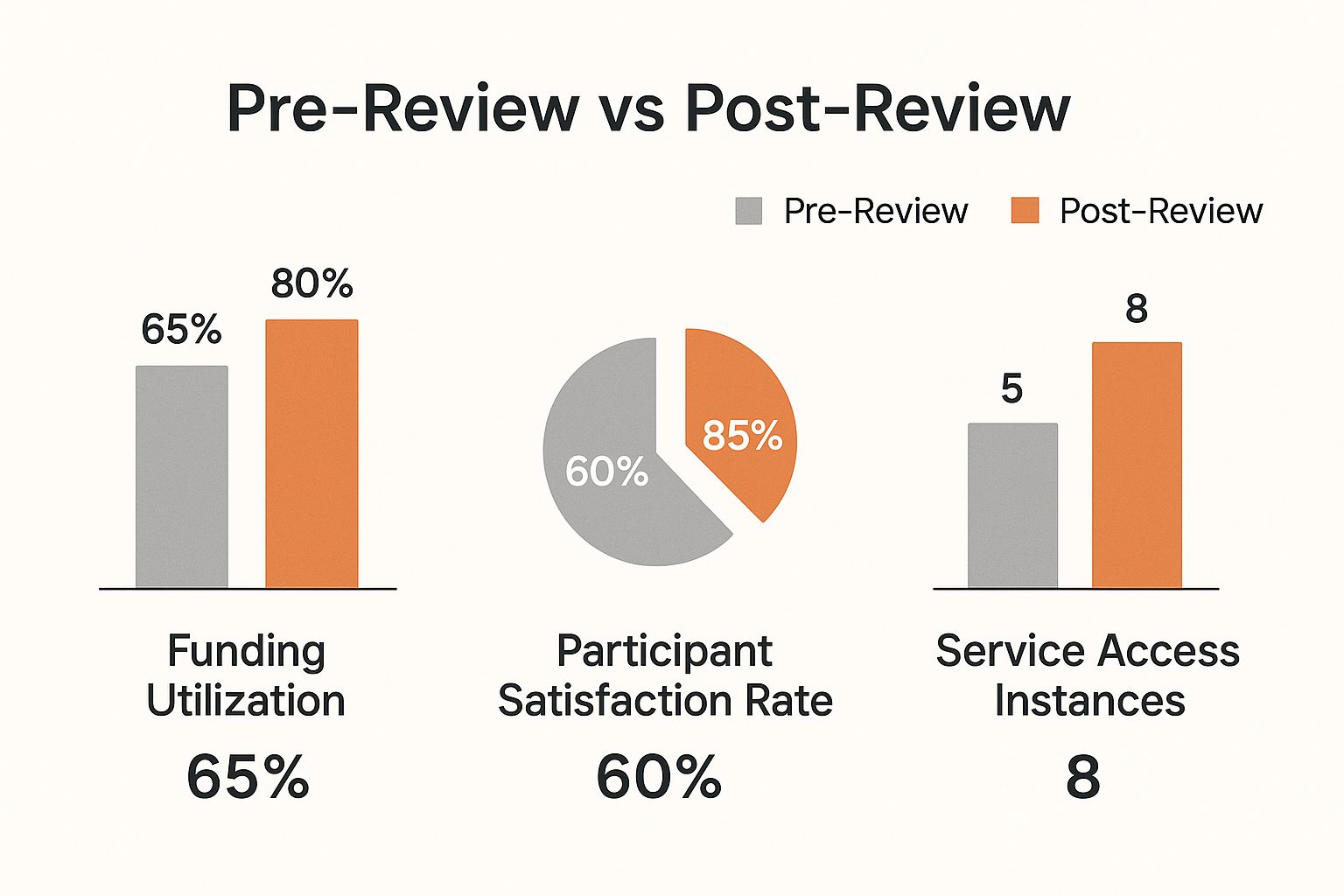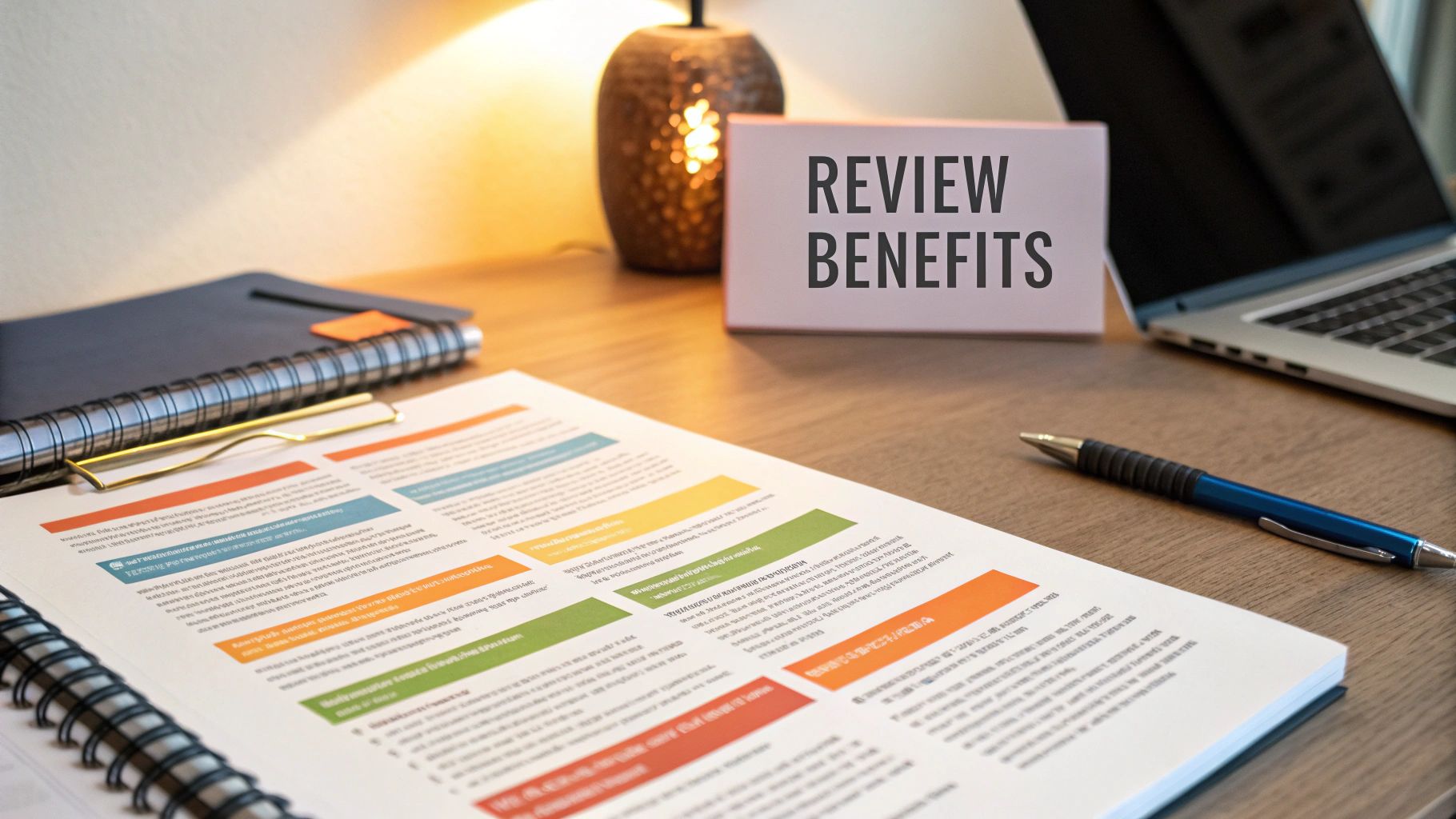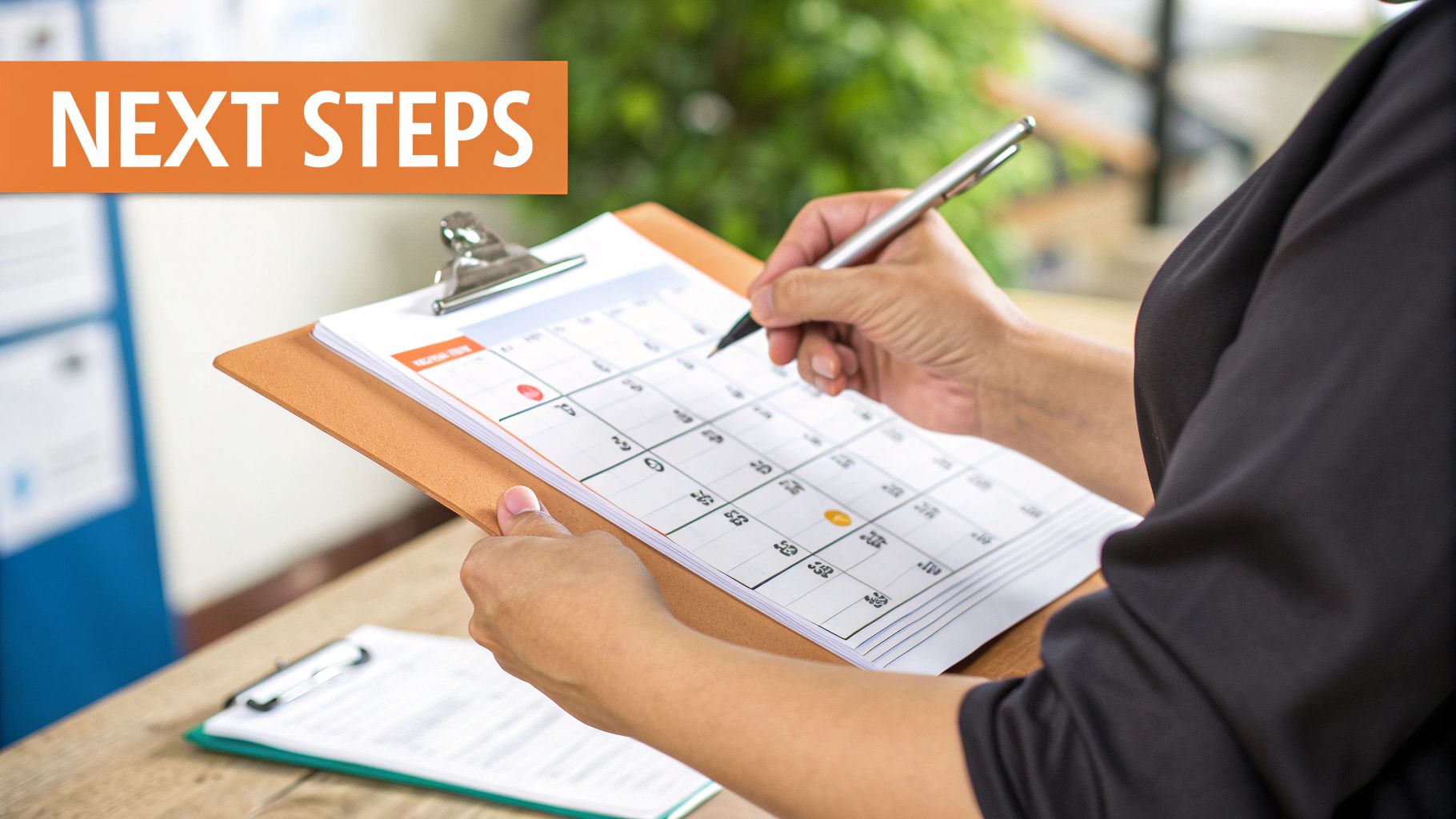Your Guide to Successful NDIS Plan Reviews
Your NDIS plan review is your chance to make sure your funding and supports truly match your life right now, as well as where you want to be in the future. It’s not a test; it’s a structured conversation with the NDIA to keep your plan relevant and working for you.
Understanding Your NDIS Plan Review
When you hear "NDIS plan review," it's easy to feel a bit overwhelmed. But it’s best to think of it as a chance to hit refresh and make sure your funding is lined up with your real-world needs. This is a standard and vital part of being on the NDIS. It gives you a moment to step back and look at what’s working, what could be better, and what you’re aiming for next.
The whole point is to build a new plan that’s an accurate snapshot of your life. It’s your time to talk about new goals you’ve set, any changes in the support you need, or even challenges you've had with your current plan. When you prepare well, you ensure your funding continues to properly support your independence and ability to participate in your community.
The Different Types of Reviews
It's helpful to know that not all NDIS plan reviews are created equal. They fall into a few different categories depending on what triggers them.
To make it clearer, here's a quick breakdown of the common review types you might encounter.
A Quick Look at NDIS Plan Review Types
| Review Type | What Triggers It | Primary Goal |
|---|---|---|
| Scheduled Review | Your plan's end date is approaching (usually every 12 months). | To create a new plan for the next period, assessing progress and setting new goals. |
| Change of Circumstances Review | A significant life event occurs (e.g., change in health, living situation, or support needs). | To adjust your current plan to accommodate the new situation immediately. |
| 'Light Touch' Review | The NDIA initiates it when your situation is stable and your plan is working well. | To quickly confirm your plan is still appropriate, often with just a phone call. |
Knowing whether your review is a scheduled one or a 'light touch' check-in helps you figure out just how much paperwork and evidence you need to pull together.
The right preparation can make a world of difference. As this image shows, a successful review can have a ripple effect across your entire NDIS experience.

The numbers back this up. A properly handled review often leads to higher satisfaction and your plan being used more effectively. The scale of this is huge—between 2016 and 2022, over 705,000 Australians applied for NDIS support, and every one of those journeys involves a review cycle.
A successful review is built on clear communication and solid evidence. It's your story, backed by facts, that demonstrates the need for specific supports to help you achieve your goals.
Getting through the review process is so much easier when you have someone in your corner. A professional can guide you through gathering evidence and defining your goals, which can completely change the outcome. If you're wondering how that works, you might find our guide on what support coordination is helpful for getting ready.
Building Your Case with Strong Evidence
Your NDIS plan review lives and dies by the quality of your evidence. It’s not just about gathering a pile of documents; it's about telling a clear, compelling story that logically connects your disability to the supports you genuinely need. If your requests are vague and don't have solid justification, they can be easily dismissed. A powerful case, on the other hand, leaves no room for doubt.

This means every single piece of evidence needs to have a clear purpose. Don't just collect reports for the sake of it. Instead, think strategically about how each document helps paint a complete picture of your daily life, your challenges, and your aspirations.
Beyond the Checklist: The Art of Compelling Reports
Let's be blunt: a generic therapist report that just lists a diagnosis isn't going to cut it. The most effective reports are the cornerstone of your funding request, and they need to do a lot more than state the obvious.
When you approach your allied health professionals for a report, you need to be specific about what it should contain. Make sure it explicitly details:
- Functional Impact: How does your disability actually affect your day-to-day life? Think about mobility, communication, social interaction, self-care, and learning.
- Support Recommendations: The report should give a clear, itemised list of recommended supports, like therapy hours, specific assistive technology, or home modifications.
- Direct Justification: This is the most critical part. The report must explain why each of those recommendations is reasonable and necessary for you to work towards your NDIS goals.
A strong therapist report doesn't just state a need; it demonstrates it. For example, instead of saying "needs occupational therapy," a powerful report would state, "requires 20 hours of occupational therapy to build the fine motor skills necessary for independent meal preparation, which is a key goal for living independently."
It's this direct link between the evidence and your goals that NDIA planners are trained to look for. If you're new to this, it can be really helpful to look through some helpful NDIS guides and resources. This will help you get a feel for the language the NDIS uses and how to frame your requests effectively.
Don't Forget Personal Statements and Support Letters
While professional reports are the backbone of your case, your own voice is just as vital. A personal statement from you, or letters from family and informal carers, can add a powerful human element that clinical reports often miss.
These documents are your chance to bring the day-to-day reality of your situation to life. A letter from a family member describing the physical strain of helping with transfers or the sheer time commitment involved in daily care can be incredibly persuasive. They see what the reports can only describe.
Here’s how to make these personal documents truly effective:
- Be Specific: Move past general statements. Instead of writing, "I need help with cleaning," describe the specific tasks you can't do and why. For example, "Due to severe fatigue and joint pain, I am unable to vacuum my home or clean the bathroom, which poses a significant health and safety risk."
- Focus on Impact: Explain what happens when you don't have the support. How does it affect your health, your safety, or your ability to be part of your community?
- Align with Goals: Always, always tie your personal story back to your NDIS goals. Clearly show how the support you're asking for will directly help you achieve what you've set out to do.
By weaving together detailed professional assessments with your own authentic, personal stories, you create a comprehensive and convincing case for your NDIS plan review. This approach dramatically increases your chances of getting the funding you need to live a better life.
How to Write Goals That Actually Get Funded
Think of your goals as the roadmap for your NDIS plan. If your goals are fuzzy or vague, your plan will be too. I’ve seen it time and time again: a poorly defined goal is the fastest way to an underfunded plan, because it leaves the planner with no clear reason to approve the supports you need.
It's a common trap. You know what you want to achieve, but getting that across in the language the NDIS understands is a whole other skill. It’s about shifting from just stating a wish to clearly explaining why a support is "reasonable and necessary" because of your disability. This single step is what transforms a hope into a funded reality.
Turning a Big Idea into a Concrete Goal
So, how do you do it? Many people find it hard to connect a big, life-enhancing goal with the small, practical supports required to make it happen. Let's walk through a real-world example.
A goal I often see is something like, "I want to improve my community connection." It's a fantastic aspiration, but for an NDIS planner, it’s far too broad. They'll likely think, "What does that actually mean for this person, and what disability-related barriers are stopping them from doing it already?"
Your job is to translate that big idea into something they can work with.
- Vague Goal: "I want to get out more."
- Actionable Goal: "I want to attend my local art class every Tuesday morning to reduce the social isolation caused by my anxiety and build new friendships."
See the difference? The second version paints a crystal-clear picture. It specifies the what, the when, and most importantly, the why. It directly links the activity to your wellbeing and community participation, which are core objectives of the NDIS.
When you're specific, you're essentially handing the planner a problem they can help you solve. The barrier to the art class might be a lack of transport, or maybe you need a support worker for the first few visits to manage social anxiety. Suddenly, your goal is directly tied to fundable supports.
Connecting Your Goals to the Money
Once you’ve nailed down a specific, actionable goal, you need to explicitly link it to the funding you’re asking for. During your NDIS plan review, you need to be the one who builds the bridge between your goal and the supports you need. Don't make the planner guess.
Let's stick with our art class example. Here’s how you’d break it down to request specific supports:
| Your Specific Goal | Disability-Related Barrier | Support You Need & Why |
|---|---|---|
| Attend a weekly art class at the local community centre. | Due to my physical disability, I can't use public transport or walk to the venue. | Funding for disability-friendly taxi services from my Core budget, ensuring I can travel to and from the class safely and reliably. |
| Attend a weekly art class at the local community centre. | My social anxiety makes it overwhelming to enter new places and meet people by myself. | 10 hours of a support worker's assistance from my Capacity Building budget to help me attend the first few sessions and get comfortable. |
This approach does the heavy lifting for the planner. It shows you've thought through your needs and are requesting supports that directly address a barrier caused by your disability. This is, without a doubt, the most powerful way to make sure your goals aren't just acknowledged, but properly funded.
Navigating Unseen Systemic Hurdles
The NDIS is designed to be a fair system for everyone, but let's be honest—sometimes, systemic issues can pop up and create unexpected barriers during your plan review. This isn't about being pessimistic; it's about being smart and prepared. When you know what hurdles might be ahead, you can build a much stronger, more resilient case for the support you genuinely need.

Think of it as being proactive. This awareness ensures your unique situation gets the attention it deserves in a system that can sometimes feel inflexible.
Challenges for Rare and Episodic Conditions
Living with a rare or episodic disability can feel like you're trying to fit a square peg into a round hole. The standard NDIS process often expects consistent, predictable evidence, but your condition might not work that way at all.
For instance, if you have a condition that flares up without warning, it’s tough to get reports that truly capture the full impact on your life. On a good day, you might seem perfectly fine, but your plan has to be built for your worst days, not your best ones.
This is where you need to become your own best advocate. Here’s how:
- Document Everything: Keep a detailed diary. Note your symptoms and exactly how they disrupt your daily life, especially during a flare-up. Photos and videos can be powerful here.
- Educate Your Planner: Never assume the planner or LAC knows the ins and outs of your condition. Bring easy-to-understand information from trusted sources (like a peak body for your condition) to help them get up to speed.
- Focus on 'Worst Day' Scenarios: All your evidence—from your own diary to your therapist's report—needs to paint a clear picture of what life is like when your symptoms are at their peak. That’s when you need support the most.
Despite the scheme’s promise of choice and control, experiences with NDIS plan reviews can be a real mixed bag. This is particularly true for people with less common conditions, where satisfaction levels can vary wildly from one person to the next.
Acknowledging Gender Disparities
The data also points to another quiet challenge within the NDIS: gender disparity. While disability impacts men and women at similar rates across Australia, there’s a noticeable gap in who is accessing the scheme. This can sometimes lead to a lack of understanding of gender-specific needs during a review.
For women, certain challenges or health issues can be misunderstood or even dismissed. This makes it absolutely critical to advocate firmly and ensure your specific needs and goals are front and centre in the conversation.
Your voice is your most powerful tool. The review is your chance to tell your story clearly and confidently. Make sure the final decision is based on your reality, not just a line item on a report.
To advocate effectively, always connect your disability to tangible, real-world impacts. How does it affect your ability to manage your home, work, or engage with your community? Getting familiar with the official guidelines also gives you a major advantage. You can read our guide on NDIS policies to get a better handle on the framework.
Ultimately, getting through these hurdles is all about empowerment. By anticipating these challenges, you can craft a more strategic and persuasive case, giving your NDIS plan review the best possible chance of success.
Your Action Plan After the Decision
That moment when your new NDIS plan lands in your inbox is a big one, but the work isn't over just yet. What you do in the first few hours and days is critical and can set the tone for your entire year. Your very first move? Sit down and read the whole thing, cover to cover. Don't just skim it.
Think of this first read-through as your quality check. You’re essentially marking the NDIA's homework, making sure the final document truly reflects your life, your needs, and the conversations you had during your NDIS plan review meeting. Never assume it's all correct.
What to Look For in Your New Plan
When you're going through the plan, the devil is absolutely in the details. A tiny error now can snowball into a massive headache down the track, so being meticulous at this stage will save you a world of pain.
Here's what you need to zero in on:
- Funding Amounts: Do the totals for your Core, Capital, and Capacity Building budgets make sense? Are they what you expected based on your discussions? Look out for any categories that seem suspiciously low or have vanished entirely.
- Support Item Numbers: If you talked about needing specific things, like a particular type of assistive tech, double-check that the correct line item number is listed. The wrong number means your provider can’t claim payment, and that’s a problem you don't need.
- Start and End Dates: Confirm the plan dates are right. A simple typo here could create a gap where you're left without any funding.
- Your Goals: Read the goals written in your plan. Are they your goals? They should be the ones you carefully prepared, not some generic, rephrased version that doesn't sound like you.
If it all looks good and the plan provides the resources you need to get on with your life, that's fantastic news! Your next step is to get it activated and start lining up your providers.
When the Plan Falls Short of Your Needs
Of course, it's not always good news. It’s a gut-wrenching but common experience to open a new plan and feel that sinking feeling of disappointment. You might see that essential supports have been cut, or the funding is nowhere near enough to cover your actual needs. If this is you, it's vital to act fast, but also to act smart.
You absolutely have the right to challenge the NDIA's decision. The first official step is to ask for an internal review. It’s crucial to know you have to lodge this request within three months of receiving your new plan. This isn't just about complaining; it's a formal process where you get to present your case again, this time with even more targeted evidence.
Don't think of this as a fight. An internal review is a standard procedural step. It gives the NDIA a chance to take a second look at the evidence and fix any mistakes they might have made.
For an internal review to be effective, you have to be crystal clear about which parts of the plan you disagree with and exactly why. Gather up your strongest evidence—your therapist reports, your personal statement, and any new documents that back up your claims—and submit it again. Your argument needs to directly address the NDIA's reasoning for their decision, if they’ve given you any.
Getting your head around the official rules can make a huge difference. You can build a much stronger case by understanding our breakdown of key NDIS policies and procedures.
If that internal review doesn't resolve the issue, your next port of call is the Administrative Appeals Tribunal (AAT) for an external review. While this is a more formal legal process, it gives you the benefit of an independent body reviewing your case from a fresh perspective. Taking prompt, methodical action gives you the best possible chance of getting a fair outcome from your NDIS plan reviews.
Your NDIS Plan Review Questions Answered

When it comes to NDIS plan reviews, a lot of the same questions pop up time and again. The whole process can feel a bit overwhelming, but getting straight answers to your concerns is the best way to feel more in control.
Let's break down some of the most common queries I hear from participants, so you can walk into your next review with confidence.
How Often Do NDIS Plan Reviews Happen?
Most NDIS plans are set for a review every 12 months, but that’s not set in stone. The exact date for your scheduled reassessment will always be clearly stated in your plan document, so be sure to check it.
What’s really important to know is that you don't have to wait for that date. If your life takes a turn—maybe your support needs change or you have new goals you want to chase—you can request an earlier review. This is officially called a 'change of circumstances' review, and it's your right to ask for one when you need it.
Can I Bring Someone to My Review Meeting?
Yes, and I strongly encourage it. You can bring a support person, an advocate, a family member, or your support coordinator to any meeting with the NDIA. Think of it as a fundamental part of the process.
From my experience, having someone you trust in the room with you is a game-changer. They can help you stay focused, take detailed notes, and prompt you if you forget to mention a crucial point. Don't ever hesitate to use this right.
Having that support is particularly valuable. For example, data shows some surprising inequalities within the scheme itself. While disability prevalence is nearly equal across genders, NDIS participants are disproportionately male (62%) compared to female (37%). An advocate can help make sure your individual circumstances are heard loud and clear, regardless of any systemic bias.
The real-world benefits of strong support are clear. You can explore a variety of client stories and experiences that show just how much of a difference having the right person in your corner can make.
What if I Disagree with My New Plan?
Opening a new plan and realising it doesn't meet your needs is tough, but it's vital to act quickly. Your first move is to request an 'internal review' directly from the NDIA. You have to lodge this request within three months of getting your new plan.
If you go through the internal review and you're still not satisfied with the outcome, don't give up. The next step is applying to the Administrative Appeals Tribunal (AAT), which provides an independent, external review of the NDIA's decision.
What Is a Light Touch Review?
A 'light touch' review is exactly what it sounds like—a much simpler, quicker check-in. It's usually for participants whose situation is stable and whose plan is working well. Often, it's just a brief phone call to confirm that everything is on track.
But here’s the key: if your needs have changed at all, a light touch review isn't for you. It's crucial to push back and insist on a full, comprehensive review to ensure your plan is properly updated with the right funding and supports.
